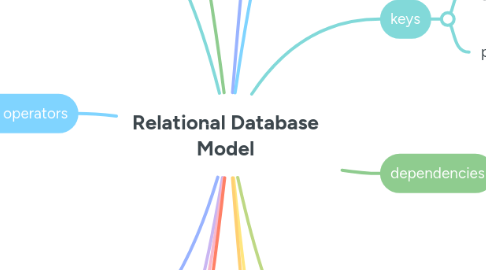
1. integrity rules
1.1. entity integrity ensures unique primary key entries
1.2. referential integrity ensures valid references between entities
1.3. constraints like NOT NULL and UNIQUE enforce data integrity
2. relational algebra
2.1. theoretical way of manipulating table contents using operators
2.1.1. SELECT
2.1.2. JOIN
2.1.3. PROJECT
2.2. based on mathematical principles
3. set operators
3.1. SELECT
3.2. PROJECT
3.3. UNION
3.3.1. combines rows
3.4. PRODUCT
3.5. DIVIDE
4. joins
4.1. inner join
4.1.1. select rows meeting a given criterion
4.2. outer join
4.2.1. retains unmatched pairs
4.3. natural join
4.4. equijoin
5. data dictionary
5.1. describes all tables in database
6. system catalog
6.1. data dictionary for the entire database system
7. Codd's relational database rules
7.1. rules outlining logical and systematic representation of data in a relational database
8. logical structure of relational database model
8.1. enables a logical representation of data and relationships
8.2. logical simplicity allows for effective database design methodologies
9. components and characteristics of relational tables
9.1. tables
9.1.1. 2D structures composed of rows and columns
9.1.2. rows : represent a single entity occurence
9.1.3. columns : represents an attribute with a distinct name
9.2. data values
9.2.1. stored at the intersections of rows and columns
9.3. all values in column must conform to the same data format
9.4. tables must have attributes or combinations that uniquely identify each row
10. keys
10.1. consist of one or more attributes that uniquely identigy rows
10.2. primary key
10.2.1. atrribute or combination that uniquely identifies a row
11. dependencies
11.1. determination
11.1.1. establishes relatinships among attributes
11.2. functional dependence
11.2.1. defines relationships where the value of one attribute determines the value of another
12. types of keys
12.1. composite
12.1.1. composed of more than one attribute
12.2. superkey
12.2.1. uniquely identifies any row in a table
12.3. candidate
12.3.1. minimal superkey
12.4. primary
12.4.1. uniquely identifies all other attribute values in any given row
12.5. foreign
12.5.1. links tables by referencing the primary key in another table
13. relationships in relational database
13.1. 1:M
13.2. 1:1
13.3. M:N
13.3.1. composite entities are used to avoid problems in M:N relationships
